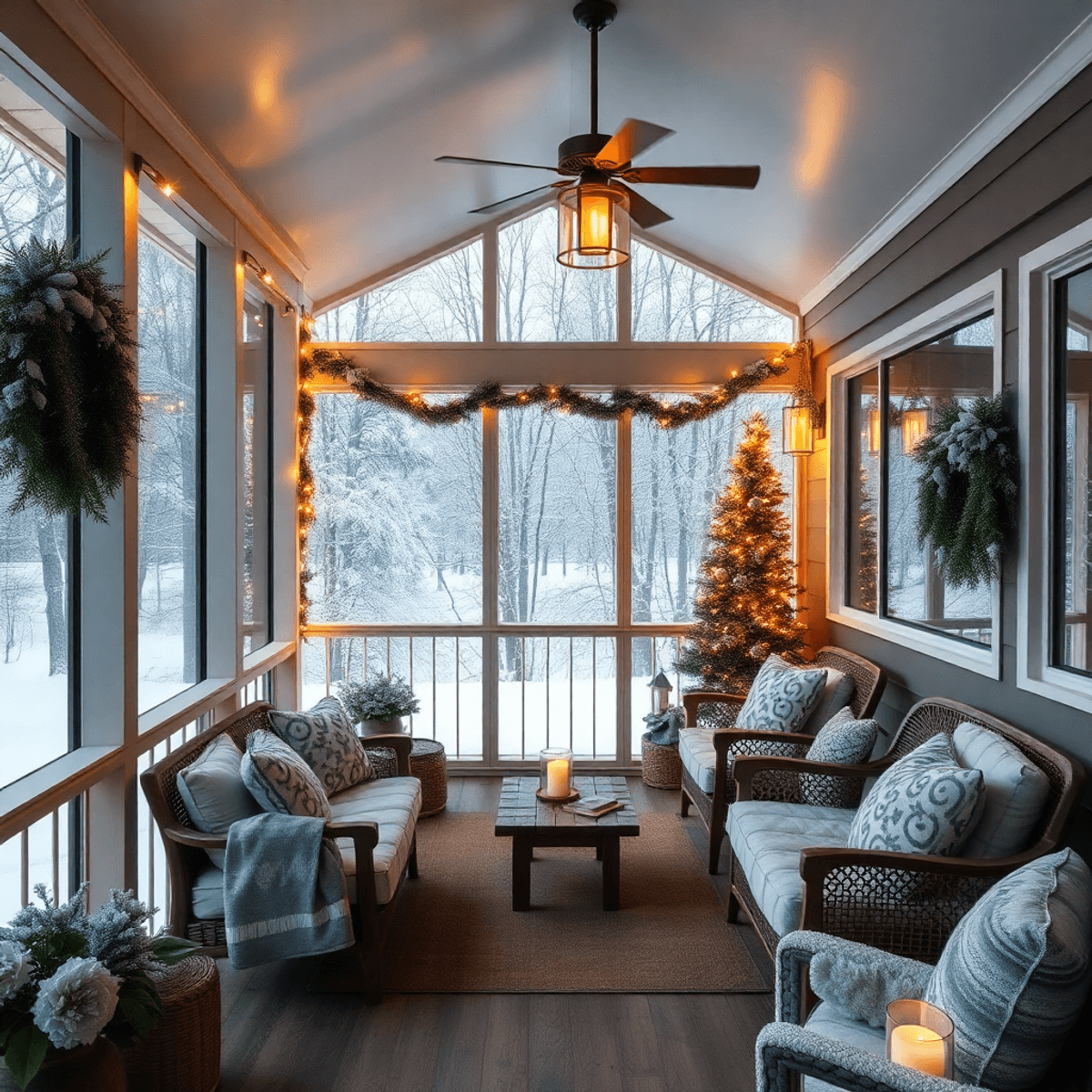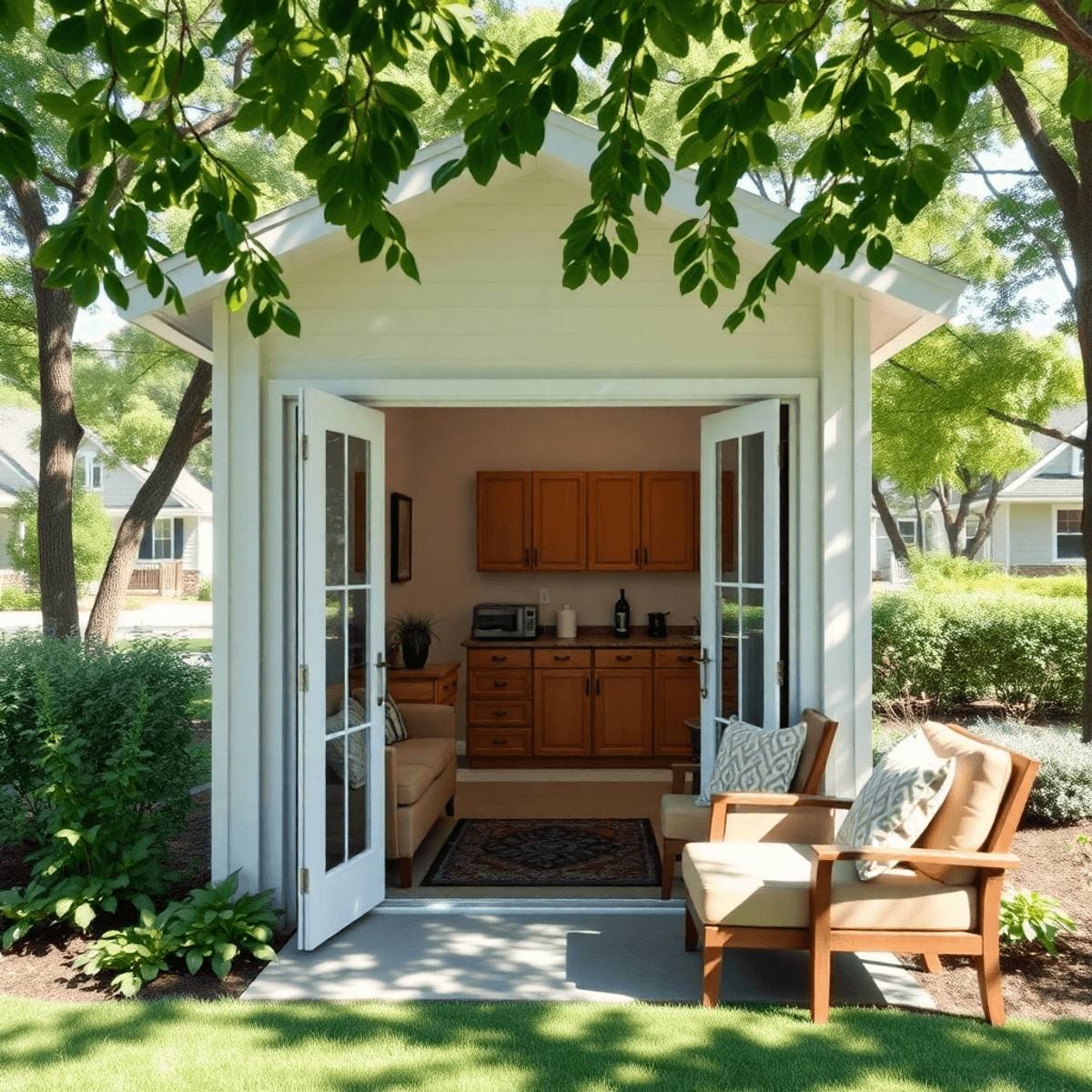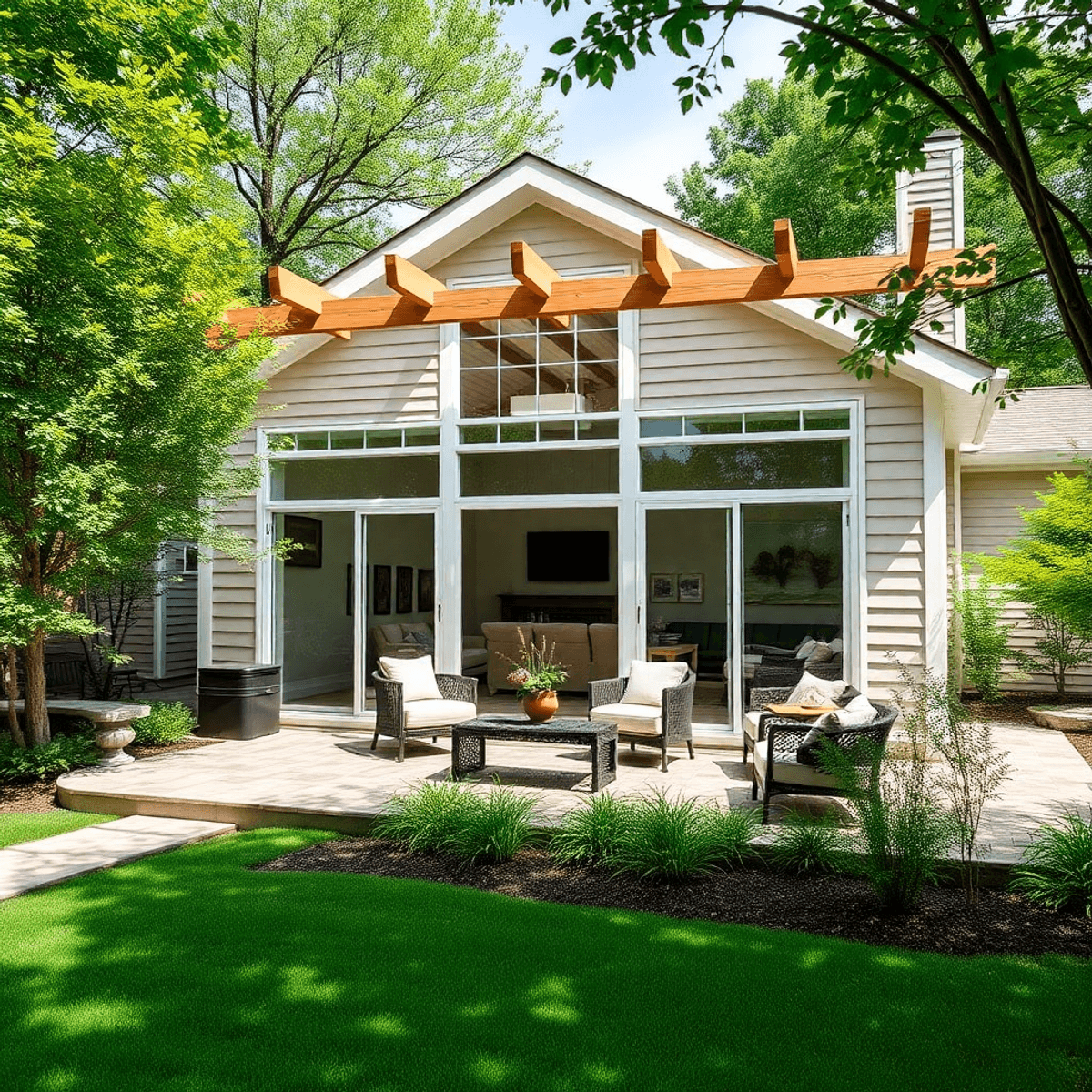Introduction
Transforming your screened porch into a space that can be enjoyed all year round is an attainable goal, especially in the varying climates of Lindenhurst and Gurnee. Winterizing your screened porch not only maximizes its usability during colder months but also shields it from harsh winter elements. This process helps maintain the structural integrity of the porch, ensuring it remains a cozy and inviting extension of your home.
Key takeaway: By effectively winterizing your screened porch, you enhance its functionality, protect it from snow, ice, and freezing temperatures, and preserve the longevity of its materials.
This article serves as a comprehensive guide to help you navigate through the steps necessary to prepare your screened porch for year-round use. Whether you’re considering minor tweaks or major renovations, such as a bathroom remodel in Lindenhurst or adding a cedar pergola in Libertyville, this resource aims to equip you with practical tips tailored for the unique climate conditions in Lindenhurst and Gurnee. For instance, if you’re looking to create a more versatile space, consider transforming your porch into a screen house in Gurnee. Additionally, our insights on design and planning can provide further assistance in making your porch a year-round haven.
Benefits of Winterizing Your Screened Porch
Winterizing your screened porch offers numerous advantages that enhance its functionality and extend its lifespan. By taking proactive steps, you can maximize use and protect the structure from harsh winter elements.
Enhancing Usability
Winterization helps maintain a comfortable environment by preventing extreme temperature fluctuations. This ensures you can enjoy your screened porch year-round, whether it’s a chilly January morning or a brisk autumn evening. With proper insulation and heating solutions, the space remains inviting regardless of outside weather conditions.
Protection Against Winter Elements
Snow, ice, and freezing temperatures pose significant threats to any outdoor structure. By properly winterizing your screened porch, you shield it from these damaging elements. This protection helps prevent issues like ice accumulation and moisture seepage that can lead to structural damage over time.
Preserving Material Integrity
Regular maintenance through winterization also means preserving the integrity of materials and screens. When exposed to harsh conditions without protection, screens can become brittle, frames may warp, and materials could deteriorate. Effective winterization reduces wear and tear, ensuring that your porch lasts longer with less upkeep required.
Additionally, while painting the porch can provide an extra layer of protection against the elements, it’s also essential to schedule regular inspections to identify any potential issues early on.
If you’re considering extending your living space further, a finished basement could be a great option. This not only increases your home’s usable area but also adds value to your property.
Moreover, when winterizing your porch, don’t forget about the importance of flooring choices as well. The right flooring can significantly impact both the aesthetic appeal and functionality of your porch during the colder months.
Finally, if you’re unsure about where to start or need professional assistance with winterizing your screened porch or any other home improvement projects, you can easily submit service requests for expert help. Investing in these strategies not only safeguards your porch but also enhances its value as an integral part of your home.
Step-by-Step Guide to Winterizing Your Screened Porch
1. Deep Cleaning and Preparing Your Screened Porch for Winter
To ensure your screened porch remains a welcoming and pleasant space, investing time in a thorough cleaning is essential before the winter season sets in. A clean porch not only enhances the aesthetic appeal but also plays a crucial role in mold prevention.
Remove Dirt and Debris
Begin by clearing away any accumulated dirt, leaves, or debris from the screens and surrounding areas. This prevents potential blockages that can trap moisture, leading to mold or mildew growth.
Effective Screen Cleaning Techniques
- Use a mild detergent solution mixed with warm water to gently scrub the screens.
- Employ a soft brush or cloth for scrubbing to avoid damaging the screen material.
- Rinse thoroughly with water to remove any soap residue, allowing the screens to dry completely.
Addressing Mold and Mildew Spores
Mold spores thrive in damp conditions, making it vital to eradicate them during your cleaning process. Consider using vinegar or a specialized mold remover on stubborn areas where mold might have started developing.
Once your screened porch is spotless, you lay the groundwork for effective winterization. With clean screens and surfaces, your efforts to insulate or protect against cold weather will be more efficient. Additionally, removing potential mold sources ensures a healthier environment for year-round use.
By prioritizing deep cleaning as the first step in winterizing your porch, you safeguard against long-term damage while preserving its charm. Continue this approach across all areas of your porch to maintain its functionality and beauty throughout every season.
If you’re considering an upgrade during this process, such as adding screen houses for better insulation or aesthetics, there are various options available that can enhance your outdoor experience even in winter. Moreover, if you find that your current setup isn’t meeting your needs anymore, it might be worth exploring whether it’s time to remodel or move. For instance, a bathroom remodel could be an excellent way to improve functionality while adding value to your home.
And if you’re dreaming of transforming your kitchen into a space that perfectly blends rustic charm and modern flair, consider embarking on a farmhouse kitchen remodel. This type of renovation can significantly enhance the overall appeal of your home.
2. Storing Fragile Items Properly to Protect Them from Winter Damage
Winterizing your screened porch involves not only cleaning screens and mold prevention but also ensuring that fragile items are stored safely. Identifying items that need extra care is crucial. Delicate decorations like glass ornaments or lightweight furniture pieces often suffer in cold, damp conditions.
Identifying Fragile Items:
- Delicate Decorations: Glass or ceramic ornaments, artworks, and other sensitive decor items.
- Lightweight Furniture: Pieces made from wicker or thin plastic that can crack under low temperatures.
Proper Storage Solutions:
- Weather-Resistant Covers: Use these for larger furniture that cannot be moved easily. They shield against moisture and cold.
- Dry Storage Spaces: For smaller items, consider moving them to a dry area such as a garage or shed. This prevents exposure to moisture and frost.
These steps in furniture storage and decor protection are essential in the winterization process. By taking these precautions, you preserve the integrity of your outdoor furnishings and decorations through the harsh winter months in Lindenhurst and Gurnee. This ensures they remain in top condition for the return of warmer weather, making your screened porch a pleasant place to enjoy year-round.
If you’re considering a kitchen remodel in Fox Lake, it’s important to plan for proper storage during the renovation process. Utilizing storage solutions can greatly assist in this regard. Additionally, if you’re looking for more home improvement ideas or inspiration, exploring our portfolio could provide valuable insights.
3. Checking Weatherstripping and Caulking Seals for Draft Prevention and Energy Efficiency
Preventing cold air drafts is crucial to maintaining a cozy atmosphere in your screened porch during the winter months. Inspecting seals around windows and doors is an essential step in this process. Look for gaps or cracks where air might seep through, as these can significantly impact the energy efficiency of your space.
To identify ineffective weatherstripping and caulking:
- Examine Existing Seals: Check for visible wear and tear or areas where the sealant has become brittle. If you notice any peeling or missing sections, it’s time for a replacement.
- Perform a Light Test: Close the door or window and shine a flashlight around the edges from one side while observing if any light passes through on the other side. Light penetration indicates potential draft sources.
- Feel for Drafts: On a windy day, run your hand along the edges to detect any cold air currents entering through compromised seals.
Replacing worn weatherstripping with new materials like foam tape or rubber gasket can effectively block drafts. Applying fresh caulk around windows and door frames not only prevents air infiltration but also contributes to mold prevention by sealing out moisture. By securing these weak points, you’ll enhance both comfort and energy efficiency in your screened porch.
4. Exploring Insulation Options to Keep Your Screened Porch Comfortable Year-Round
When winterizing your screened porch, insulation becomes a key factor in maintaining comfort throughout the year. Vinyl sheeting, which is often used in vinyl flooring, stands out as an ideal insulation material due to its affordability and ease of installation. These heavy-duty vinyl curtains or clear vinyl sheets provide a protective barrier against cold winds, helping to maintain a cozy atmosphere.
Here’s how you can install these vinyl solutions effectively:
- Measure and Cut: Begin by measuring the dimensions of each screen panel on your porch. Cut the vinyl sheeting accordingly to ensure full coverage.
- Secure Installation: Use Velcro straps or adhesive hooks to attach the vinyl sheeting securely along the edges of your porch screens. This allows for easy seasonal removal without damaging the structure.
- Prevent Gaps: Ensure there are no gaps between the vinyl sheets and the frame, as this can compromise insulation efficiency.
By integrating these vinyl solutions, not only do you protect against drafts, but you also enhance mold prevention by keeping moisture at bay. This step is crucial for preserving both furniture storage and decor protection during colder months.
This detailed guide on using vinyl insulation will help you effectively navigate the process of how to winterize your screened porch for year-round use in Lindenhurst and Gurnee.
5. Considering Heating Solutions for Added Comfort During Cold Months
When winterizing your screened porch in Lindenhurst and Gurnee, introducing a reliable heat source can transform it into a cozy retreat. There are various heating options suitable for this purpose:
1. Electric Space Heaters
These devices offer portability and ease of use, making them an attractive choice for screened porches. They can efficiently warm up the space, ensuring comfort during colder months. Look for models with adjustable thermostats and safety features like tip-over protection.
2. Propane Patio Heaters
Known for their powerful heat output, propane heaters are ideal for larger areas. They can quickly elevate the temperature of your porch, making it hospitable even on chilly days. Ensure you have proper ventilation to prevent the buildup of fumes.
Safety is paramount when using outdoor heating solutions. Always maintain clearances between the heater and any flammable materials, such as furniture or decorations. Regularly inspect all equipment to ensure it’s in good working order and free from damage.
This comprehensive guide on how to winterize your screened porch includes detailed insights into each step of the process, from cleaning screens and preventing mold to effective furniture storage and decor protection. By selecting the right heating solution, you enhance both comfort and utility throughout the year.
6. Timing Your Winterization Efforts Appropriately Based on Local Climate Conditions
In Lindenhurst and Gurnee, timing your winterization efforts correctly ensures that your screened porch remains a cozy retreat throughout the colder months. Starting preparations early can be key to effective winterization, particularly due to the area’s climate patterns.
Recommended Timeline:
September to October: Begin by deep cleaning your screens. This helps in mold prevention and sets the stage for further winter-proofing tasks.
Late October: As temperatures start to drop, focus on furniture storage and decor protection. Remove or cover items that might not withstand the cold or moisture.
Early November: Inspect and repair any weatherstripping or caulking around windows and doors to prevent drafts.
This timeline aligns with typical weather conditions in Lindenhurst and Gurnee, allowing you ample time to prepare before winter’s harshest elements arrive. By adhering to this schedule, you can ensure every aspect of how to winterize your screened porch for year-round use is covered efficiently. Each step comes with its own detailed guide, so you’re never left wondering what to do next.
Additionally, while preparing for winter, it’s also a good opportunity to consider some home remodeling projects. Many homeowners in Gurnee are currently budgeting for their home remodel, which could include enhancing their screened porches for better year-round usability.
7. Deciding Between Professional Help or DIY Methods for Your Winterization Project
Deciding whether to hire a professional or take on the winterization of your screened porch yourself is a crucial decision. Both options have their own advantages and things to consider.
Professional Services:
Pros:
- Expertise in identifying potential issues such as ineffective weatherstripping and caulking, which can lead to drafts.
- Access to high-quality materials and tools specifically designed for protecting against elements like snow and ice.
- Time-saving, as professionals can complete the project efficiently.
Cons:
- Higher cost compared to DIY methods, which may not align with budget-friendly options.
- Less personal control over the specific choices made during the winterization process.
However, hiring professionals doesn’t always have to be expensive. For instance, if you’re considering a more extensive renovation project while winterizing, such as finishing your basement, it might be worth investing in professional services. Similarly, if your winterization project involves significant changes to your kitchen, you might want to consider custom kitchen cabinets instead of opting for big box retailer options.
DIY Approach:
Pros:
- Greater flexibility in choosing materials, like vinyl sheets or curtains, to fit your personal style and needs.
- Budget-friendly, allowing you to manage the costs more effectively by sourcing affordable solutions for cleaning screens and implementing mold prevention strategies.
Cons:
- Potential for overlooked details that could impact the effectiveness of your winterization efforts.
- Requires time and effort to learn each step involved in the process, from furniture storage to decor protection.
Whether you choose professional assistance or opt for a DIY approach, each path offers unique benefits to help you achieve a cozy outdoor space. Understanding these options will guide you in making an informed decision tailored to your specific needs in Lindenhurst and Gurnee.
Conclusion: Enjoying a Cozy Outdoor Space All Year Round Through Effective Winterization Strategies!
By following the strategies outlined, you can turn your screened porch into a comfortable extension of your home, allowing you to enjoy it throughout the year. The steps discussed not only protect against harsh winter weather but also improve the comfort and usability of your porch.
- Take Action: Implement these winterization techniques to maximize the potential of your outdoor space.
- Year-Round Use: Enjoy the peace and comfort of your porch in every season, from the snowy winters of Lindenhurst and Gurnee to the lively springs.
With careful planning, your screened porch can become a beloved getaway no matter what the weather is like. Remember these tips on how to winterize your screened porch for year-round use and create a welcoming environment that meets all your needs throughout the year.
Also, while you’re working on improving your outdoor area, don’t forget about the inside. If you’re thinking about any renovations, such as budget-friendly bathroom upgrades, there are clever methods available that can help you save money while greatly increasing your home’s value.
FAQs (Frequently Asked Questions)
What does it mean to winterize a screened porch?
Winterizing a screened porch involves taking steps to prepare the space for cold weather, ensuring it remains usable year-round. This includes protecting it from winter elements, preventing damage, and maintaining a comfortable environment.
What are the benefits of winterizing my screened porch?
Winterizing your screened porch enhances its usability throughout the year, protects its structure against snow and ice, and preserves the integrity of materials and screens, ultimately requiring less maintenance.
How should I begin winterizing my screened porch?
Start by deep cleaning your screened porch to remove dirt, debris, and potential mold spores. Use a mild detergent solution and a soft brush or cloth for effective screen cleaning.
What items should I store away during winter?
Identify fragile items such as delicate decorations and lightweight furniture that should be removed from the screened porch during winter months. Store these items in a dry area like a garage or shed using weather-resistant covers.
How can I prevent drafts in my screened porch during winter?
Inspect the weatherstripping and caulking around windows and doors for any gaps or damage. Replace ineffective seals to prevent cold air drafts from entering your screened porch.
What heating solutions are recommended for a winterized screened porch?
Consider using electric space heaters or propane patio heaters as heating solutions for your screened porch. Ensure proper ventilation and keep flammable materials away from heat sources for safety.






Leave A Comment